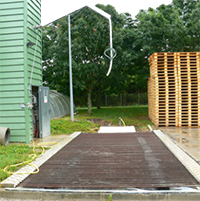More about the results
Reduction of polluant load
The global reduction rate depends on the farms agricultural practices (phytosanitary products used, frequency of the phytosanitary treatment and rinse pratices), and on outdoor conditions (temperature, sunlight, etc.).
On the 4 prototypes, 82 different active substances were detected.

Observed reduction rates showed that polluant load had no impact on the efficiency of the bacterial biodegradation.
| During 2015, 9,5 kg of active substances from phytosanitary products were captured on the Phytobarre storage tanks. Bacteria have degraded 7,7 kg, resulting in an average reduction rate about 82 %. |
The bacteria biodegradation may have been underestimated because sampling was not scheduled on the addition of effluents in the prototypes : the part of the degradation occuring between the addition of effluents and the next sampling was not taken into account.
Glyphosate and AMPA
Glyphosate is a systemic herbicide, top selling in France. Glyphosate and AMPA (aminomethylphosphonic acid, major breakdown product of Glyphosate) are the widest substances detected on the measuring points in surface waters in France[i].
On the 4 prototypes, 6,2 kg of glyphosate were captured indicating that glyphosate represent 65% of the global polluant load in the storage tanks .
The bacterial reduction of the Glyphosate pollution load is about 80% on average.
AMPA degradation was observed but the actual degradation rate could not be calculated because of simultaneous production resulting from glyphosate breakdown.
Copper
Copper is a phytosanitary product used to protect cultures, especially in wine cultivation and arboriculture. 736 g of copper was captured by the PhytoBarre prototypes. Despiste its antibacterial properties, it had no impact on bacterial biodegradation. Copper clearance of effluents occured by sedimentation down to the bottom of the storage tank, as for supended particles (clay).
Conclusion In 2015, the results indicate a 82% reduction of pollution load on average for the 82 active substances identified in the storage tanks . The 2016’s results, are expected to confirm the efficiency of the PhytoBarre process. |
[i] Les pesticides dans les cours d’eau français en 2013- Chiffres&statistiques- Commissariat général au développement durable-novembre 2015.
Read more







